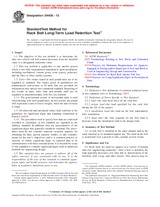We need your consent to use the individual data so that you can see information about your interests, among other things. Click "OK" to give your consent.
ASTM D4436-13
Standard Test Method for Rock Bolt Long-Term Load Retention Test
STANDARD published on 1.11.2013
The information about the standard:
Designation standards: ASTM D4436-13
Note: WITHDRAWN
Publication date standards: 1.11.2013
SKU: NS-27203
The number of pages: 5
Approximate weight : 15 g (0.03 lbs)
Country: American technical standard
Category: Technical standards ASTM
Annotation of standard text ASTM D4436-13 :
Keywords:
anchors (rock), field testing, loading tests, mines, pull testing, rock, ICS Number Code 93.020 (Earth works. Excavations. Foundation construction. Underground works)
Additional information
| Significance and Use | ||||||||
|
5.1 Rock bolts are used for support in a variety of mining and civil engineering situations.5.2 The local characteristics of the rock, such as roughness of the borehole and induced fractures, are significant factors in the load loss characteristics of the bolt. To obtain realistic values, the test holes should be drilled using the same methods as those used for the construction boreholes. 5.3 In establishing a testing program, the following factors should be considered: 5.3.1 Load retention tests should be conducted in all rock types where construction bolts will be installed. If the rock is anisotropic, for example, bedded or schistose, the tests should be conducted in the same orientations relative to the anisotropy as the construction bolts will be installed. 5.3.2 In each rock type, at each orientation, and for each anchor system, a sufficient number of tests should be conducted to determine the average and minimum long-term capacities within a fixed uncertainty band at the 95 % confidence level. The allowable uncertainty band depends on the project and involves such factors as rock quality, expected project lifetime, and importance of the areas to be bolted. The uncertainty band determination will require considerable engineering judgment. As a rough guideline, at least six long-term tests for a single set of variables have been found necessary to satisfy the statistical requirements. 5.3.3 The design load and installation load on the rock bolt system should be predetermined. The installation load is less than the anchor capacity, as determined by Method D4435. The design load is less than the installation load; the amount depends on rock properties and the minimum time required to encapsulate the bolts. Alternatively, this method can be run for a predetermined time interval based on construction requirements, and a realistic design load can be determined from the data. 1.1 The objective of this test
method is to determine the time over which rock bolt tension
decreases from the installed value to a designated minimum
value.
1.2 This test method is applicable to any anchor system which is not fully encapsulated immediately upon installation, including mechanical, cement grout, resin (epoxy, polyester, and the like) or other similar systems. 1.3 The values stated in inch-pound units are to be regarded as standard. The values given in parentheses are mathematical conversions to SI units that are provided for information only and are not considered standard. Reporting of test results in units other than inch-pounds shall not be regarded as nonconformance with this test method. 1.3.1 The gravitational system of inch-pound units is used when dealing with inch-pound units. In this system, the pound (lbf) represents a unit of force (weight), while the unit for mass is slugs. 1.4 All observed and calculated values shall conform to the guidelines for significant digits and rounding established in Practice D6026. 1.4.1 The procedures used to specify how data are collected/recorded or calculated, in this standard are regarded as the industry standard. In addition, they are representative of the significant digits that generally should be retained. The procedures used do not consider material variation, purpose for obtaining the data, special purpose studies, or any considerations for the user’s objectives; and it is common practice to increase or reduce significant digits of reported data to be commensurate with these considerations. It is beyond the scope of this standard to consider significant digits used in analytical methods for engineering design. 1.5 This standard does not purport to address all of the safety concerns, if any, associated with its use. It is the responsibility of the user of this standard to establish appropriate safety and health practices and determine the applicability of regulatory limitations prior to use. |
||||||||
| 2. Referenced Documents | ||||||||
|
We recommend:
Updating of laws
Do you want to be sure about the validity of used regulations?
We offer you a solution so that you could use valid and updated legislative regulations.
Would you like to get more information? Look at this page.




 Cookies
Cookies
